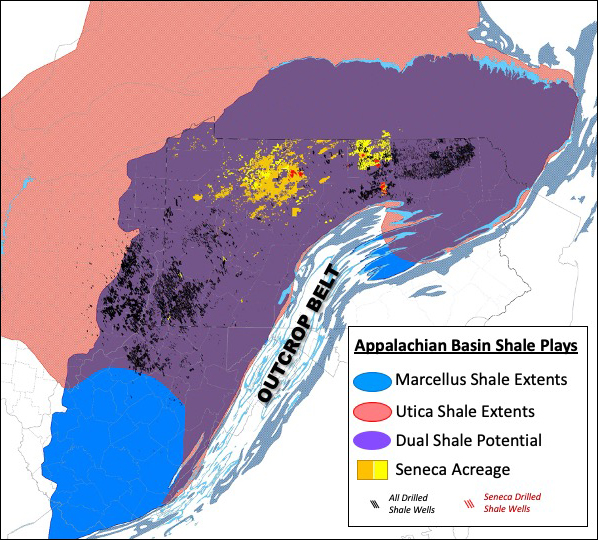Emergency Hotline
If you need to report an emergency, you can contact Seneca Resources 24 hours a day, 7 days a week at 1-800-526-2608 in Pennsylvania.
Landowner Questions
For landowner inquires or concerns, please contact The Land Department at 412-548-2600 or at landadmin@srcx.com.
The Marcellus Shale
The Marcellus Shale is a rock formation deposited around 390 million years ago. It underlies large portions of West Virginia, Pennsylvania, and eastern Ohio, and southern New York. The Marcellus is an organic-rich source rock for hydrocarbon generation. The formation is very fine-grained which results in very low permeability; as a result, the Marcellus was not a viable target for commercial oil and gas activity. However, thanks to advances in both drilling and completion technology, this formation is now considered one of the most prolific natural gas fields in the world. The most productive area for developing the Marcellus is where the formation is at least 5,000 feet below the surface. It is productive down to over 9,000 feet.
Our Marcellus Shale program began in 2007 with a network of exploration or test wells drilled across our acreage. “Testing” simply refers to collecting data in order to understand where the formation might be most productive.
Examples of test data include:
Core analysis
Measurements made on an impact sample taken directly from the rock formation of interest during drilling. Measurements include porosity, pore fluid composition, mineralogy, thermal maturity, and mechanical strength properties.
Geophysical log analysis
Geophysical logs are tools that measure rock properties at the location and depth at which they were encountered in the wellbore. Tools are lowered into the well and measure rock properties of the rock wall. Measurements include hydrogen content, bulk density, electrical properties, and acoustic properties. Like core measurements, these datasets can be used to determine rock properties but for less cost.
Exploration well testing
An exploration well is where all the hard work and analysis done by Seneca Resources it put to the test. The behavior of the exploration well is closely monitored to understand if the reservoir can be economically developed and to determine what changes in well design might result in improved production performance.
We have tested the Marcellus across much of our acreage, which provides us with detailed knowledge about the geology underlying our operating areas, thereby giving us a unique advantage in the basin.
What changed the Marcellus from a nonproductive source rock to a major natural gas producer? The answer is combining horizontal drilling techniques with hydraulic fracturing to stimulate the formation. The shale has low permeability—the very small spaces between grains don’t let natural gas, water or liquid hydrocarbons flow easily—so hydraulic fracturing enables us to create fractures in the shale to increase the flow of natural gas. These fractures are created and propped open when a mixture of water, sand and a minimal amount of chemical compounds are injected at high pressure into the formation. Once the fractures are created, the natural gas can be extracted. Since 2007, Seneca Resources has collectively drilled and completed more than 400 horizontal Marcellus wells.
The Marcellus Shale is represented in the below outcrop map.
The Utica Shale
The Utica Shale is a hydrocarbon-bearing formation deposited around 450 million years ago in a marine environment. It sits several thousand feet below the Marcellus Shale throughout the Appalachian Basin, including Pennsylvania. Seneca Resources first targeted the Utica Shale in 2011 and has tested it across much of its acreage.
With a solid understanding of the formation, we have focused Utica development in Elk, Cameron and McKean counties in the western portion of our Pennsylvania acreage, and Tioga County in the eastern portion.
Generally, well performance is stronger in the Utica than the Marcellus in the same area. This is due to greater thickness of the reservoir and higher reservoir pressure due to its greater depth—more than 10,500 feet below the surface in the west and 12,000 feet in the east.
See our outcrop map for representation of the Utica Shale.
A major advantage of having a “stacked” play strategy utilizing multiple rock formations is that it allows us to take advantage of existing infrastructure. By making repeat visits to previously used pads, environmental impacts are minimized and greater cost savings are realized.

